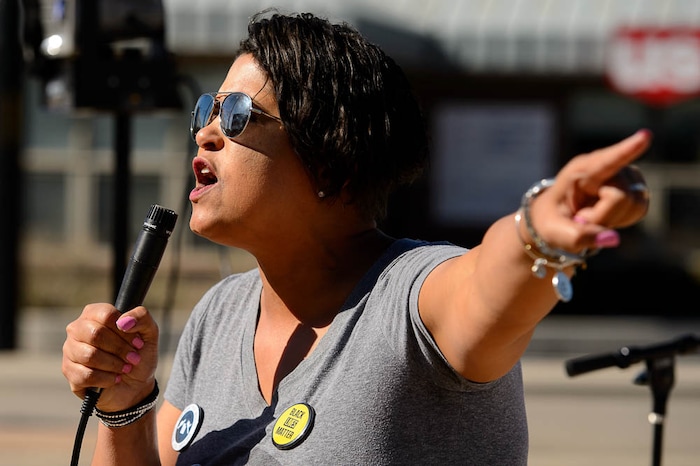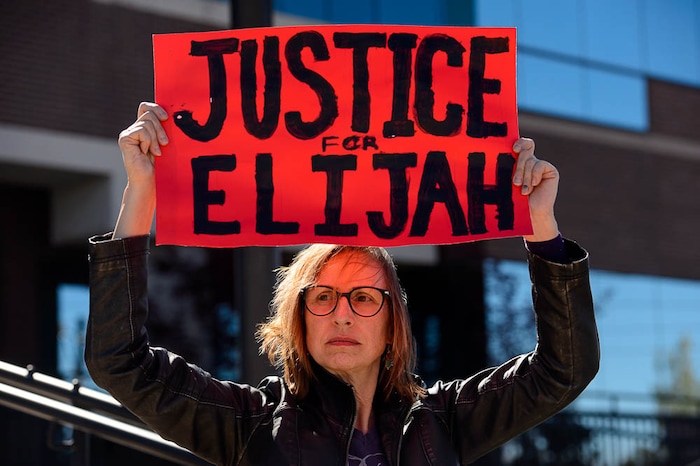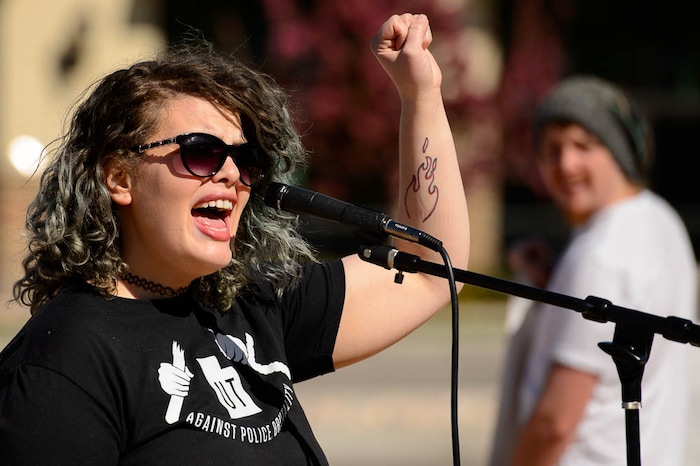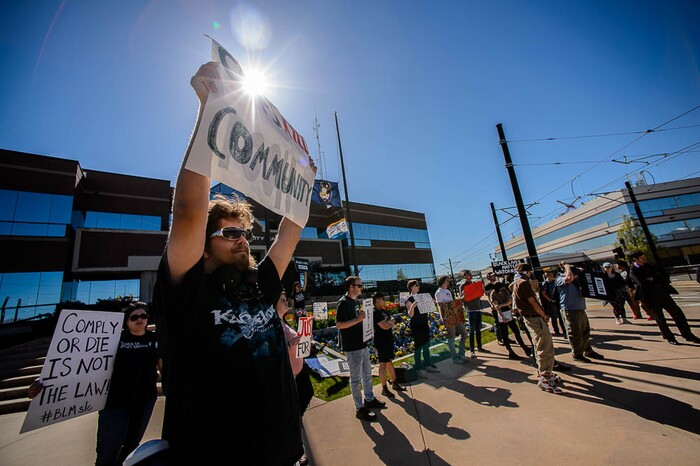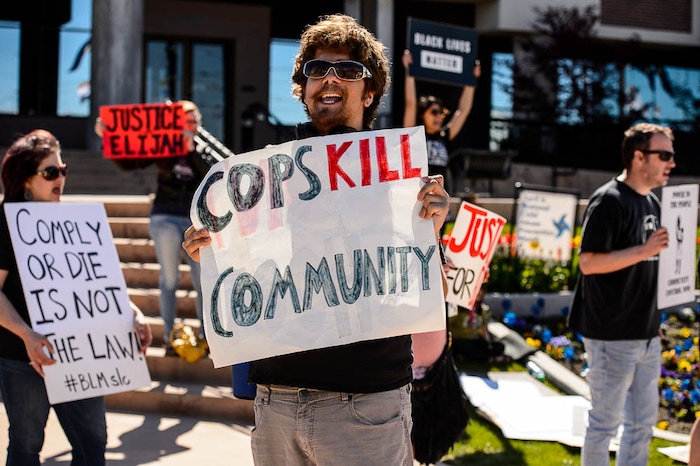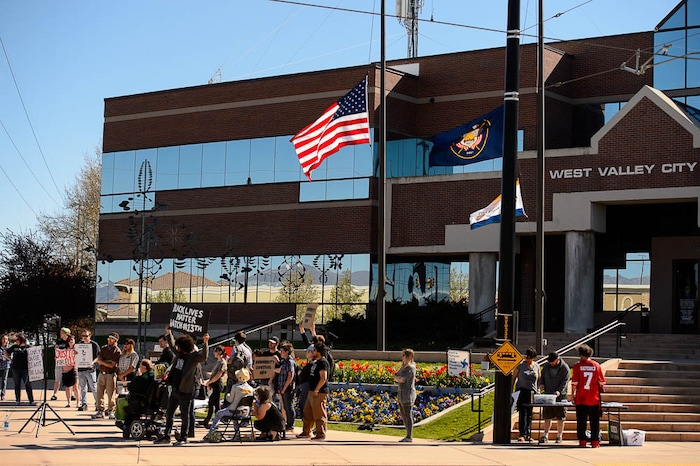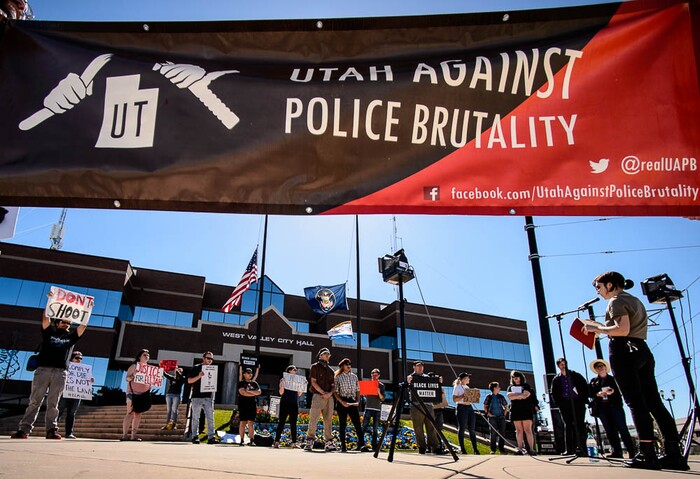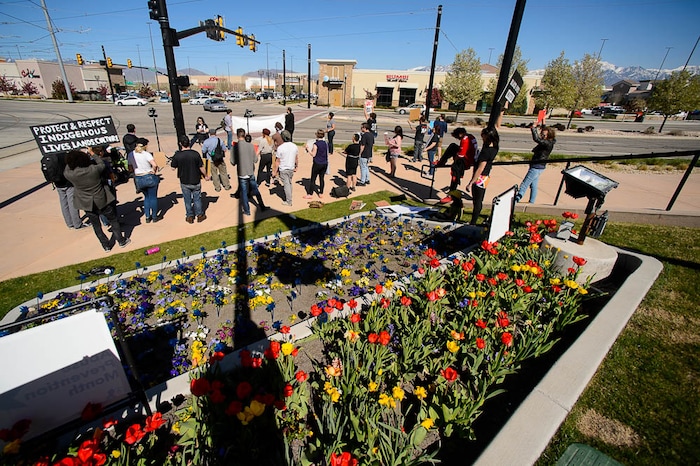West Valley City • Clutching a stack of protest signs, Francesca Ball asked a crowd what they were doing there, on the corner of a busy street outside West Valley City City Hall, on a Saturday. Again.
“Because there are killer cops,” a woman shouted in response.
“Justice for Elijah Smith,” a man said.
But those weren’t the answers Ball was looking for. She wanted to know why police keep killing people. She wondered if anyone could give her a good answer for that.
“How many more signs like this do we need to make?” Ball asked, shuffling the white pieces of poster board in her hands, displaying the nearly identical signs: “His name is Darrien Hunt,“ “His name is Patrick Harmon,” and “His name is Dillon Taylor.”
“How many names? How many different names?” she asked.
On Saturday, Utah Against Police Brutality, Black Lives Matter and the Brown Berets rallied to fire, charge and jail the West Valley Police officer who fatally shot 20-year-old Elijah Smith, who was black, on April 8. Recently released body camera footage shows an officer shot Smith as the young man “rapidly,” as police said, took his right hand out of his pocket. His left hand was already raised in the air.
While Smith’s recent death has attracted the most attention from activist groups, he is only one of four people fatally shot by law enforcement in Salt Lake County this year. In the first four months of 2018, law enforcement in Salt Lake County have used lethal force seven times, compared to six instances last year, District Attorney Sim Gill said.
Since GIll was elected eight years ago, he said the all-time high number of police shootings in a single year was about 10.
Of the seven shootings this year, in a county that identifies as 72 percent white, at least four involved people of color. Three of those people died, while a teenager described as Latino was critically injured.
Authorities have not released the identities of the people involved in a Feb. 12 shooting in Salt Lake City, where an Adult Probation and Parole officer fired a weapon, but no one was hit.
The shootings, no matter the outcome, impact everyone the county.
“[The deaths] takes a toll on our community. It takes a toll on people who are injured, their families,” Gill said. “It takes a toll on the law enforcement, which finds itself having to use that force, and there is a constant tension and concern.”
(Courtesy Salt Lake County jail) Justin Gary Llewelyn
(Courtesy Salt Lake County jail) Bryan Keith Liles
(Courtesy Salt Lake County jail) Elijah James Smith
The shootings
Salt Lake County’s first officer-involved shooting of the year happened Jan. 20 at a Riverton apartment complex, where Justin Gary Llewelyn was allegedly spotted prowling near some cars.
When Unified Police Department officers started following the man, Llewelyn, who is white, reportedly fired at them, causing police to return fire.
Llewelyn wasn’t hit and allegedly shot a civilian before stealing his car and leaving the area. He was caught five days later and is now awaiting trial on various charges.
Gill’s office ultimately found the officers were justified in shooting at Llewelyn.
Scant information is available after the remaining officer-involved shootings because of the valleywide Officer Involved Critical Incident Protocol, which mandates an outside agency investigate when a police officer fires his or her weapon.
Once the protocol is triggered, the responsible agency releases only limited information, which is first cleared by the investigating agency. The district attorney’s office hasn’t ruled on any of the following shootings:
• Feb. 12: An Adult Probation and Parole officer fired at someone during a burglary attempt in Salt Lake City. Department of Corrections spokeswoman Kaitlin Felsted said she couldn’t release any additional information because of the open investigation.
• March 13: A Bureau of Alcohol, Tobacco, Firearms and Explosives agents shot and killed 31-year-old Bryan Keith Liles, who is white, in what Liles’ father has said was a case of mistaken identity.
• March 22: A Granite School District police officer shot through the windshield of a car full of teenagers, described as Latino, after the car “lurched” forward and threw the officer onto its hood.
The driver, who was hit, was taken to the hospital in “very critical condition.”
(Trent Nelson | The Salt Lake Tribune) Law enforcement at the scene after an incident where a man barricaded himself in a house on Princeton Avenue near 1100 East in Salt Lake City, Wednesday April 18, 2018.
(Rick Egan | The Salt Lake Tribune) Investigators from West Valley and Unified Police investigate an officer involved shooting, leaving the suspect dead, in West Valley City, Sunday, April 8, 2018.
• April 8: West Valley City police shot and killed Smith after he ran from officers, who were searching for someone suspected of stealing a cellphone. Smith tried to hide inside a home in West Valley City. Officers said they found a screwdriver on the ground next to Smith after he was shot and two cellphones in the home.
• April 17: Unified officers killed Lonnie Marcel Bowen, who was allegedly holding a woman hostage when he was shot.
Days before his death, Bowen, who is black, predicted in a series of Facebook videos that he’d die at the hands of police.
• April 18: Salt Lake City police fatally shot 32-year-old Delorean Pikyavit, who is Native American, outside a home in the Sugar House area after someone reported a domestic violence incident.
(Trent Nelson | The Salt Lake Tribune) Utah Against Police Brutality holds a rally in front of West Valley City Hall, Saturday April 21, 2018. Elijah Smith was killed by West Valley Police on April 8 after he ran from them into a home. They shot him in the home's garage, while one hand was in the air and the other, activists say, appeared to be coming up, too. After body camera footage was released, the group began to call for the officer's firing. Nora Somer.
Rallying for change
Gill said it’s concerning anytime there is a police shooting, though he added that there’s “no magic number” that should elicit a certain kind of response, and, since there’s no “crystal ball,” it’s unclear how the rest of the year will play out.
He said his office considers whether the shootings were justified under the law. For a shooting to be justified, the officer must “reasonably” believe that lethal force is necessary to prevent his or her own death or serious injury or someone else’s.
“Now, if the broader issue is, you know, why are those occurring, those broader issues of social justice and those systemic issues, that’s a very different conversation,” he said.
Making changes on that level requires legislative action and community input, he said.
In some cases, Gill is talking about what demonstrators showcased Saturday in West Valley City, with their signs and megaphones, calling for change and asking tough questions about policing — such as who polices the police.
Demonstrator Carly Haldeman made the case for a civilian police accountability council, a democratically elected group of civilians that could investigate police use of force.
“We’re sick of police policing the police. Why are police policing the police? It makes no sense. It is completely absurd that we would have them investigate themselves,” she said, adding that’s part of why officers are seldom charged after they shoot and kill someone.
The next time someone is killed at the hands of police, protesters said, they’ll be back out, no matter how tired they are of doing it, no matter how many signs they have to make, or how many times they miss out on a beautiful, sunny Saturday, or have to stand outside in the rain, as they have the past several years.
Jade Arter, with Utah Against Police Brutality, said it’s easy to give up when juggling life and advocating for change, but that protesters should turn their exhaustion into anger for the people lost and a call for change, instead of sinking into apathy and complacency.
“We need to feel the loss of those souls and come together to demand better, for them, for us, for their children and for our children,” Arter said, “for our future.”
